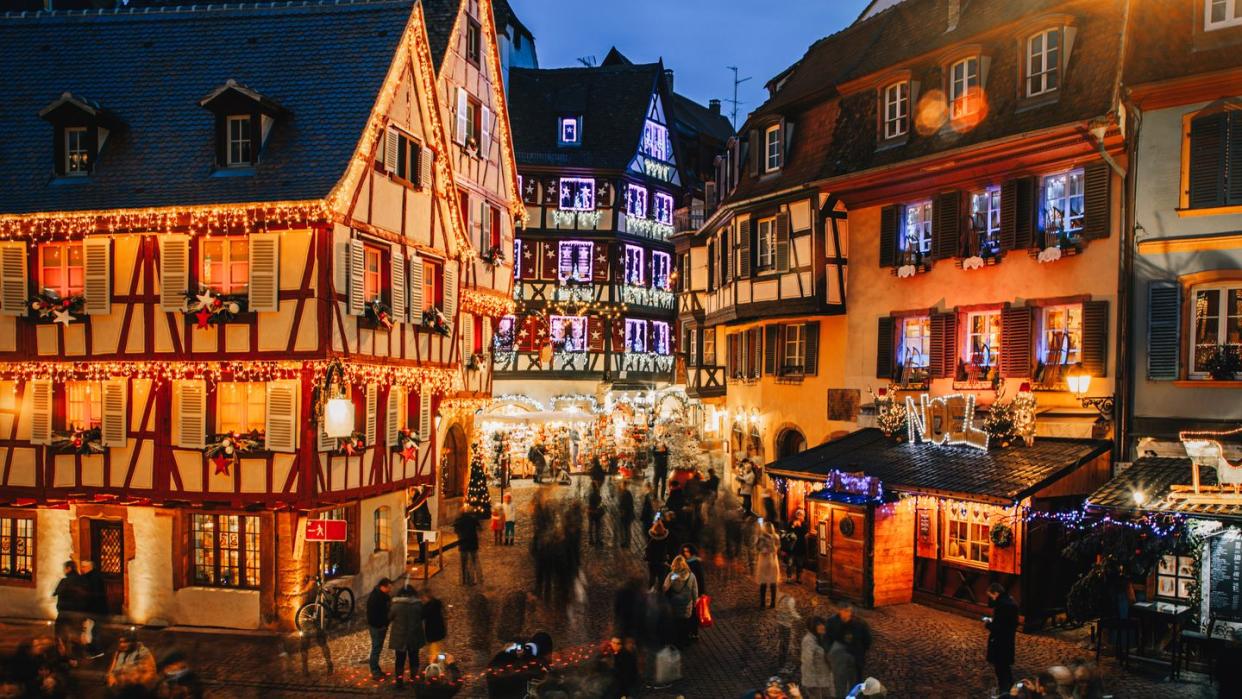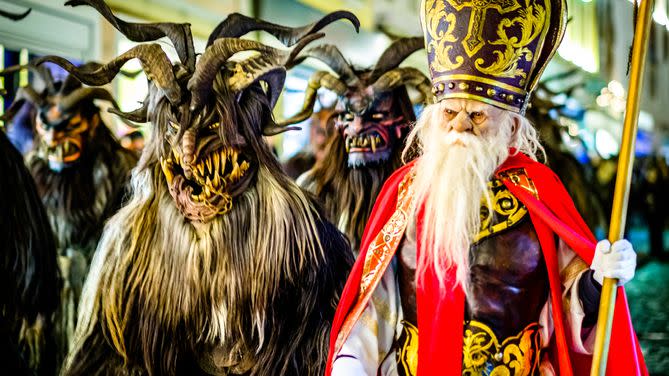How Many of These Global Christmas Traditions Have You Heard Of?

"Hearst Magazines and Yahoo may earn commission or revenue on some items through these links."
Christmas in the United States typically involves a visit from Santa Claus, gifts piled underneath a decorated tree, and churchgoers attending mass to celebrate the birth of Jesus Christ. Beyond these customs, however, families tend to have their own special ways of observing the holiday.
For example, some exchange Secret Santa gifts on Christmas Eve, eat finger foods, and watch Christmas movies. Some people throw casual holiday parties for their friends, while others lavish family members who've traveled from afar with Pinterest-perfect sit-down dinners.
Christmas traditions around the world are just as diverse, with different countries holding their own unique customs and celebrations. These customs below provide a glimpse of how different parts of the world celebrate Christmas.
Christmas Traditions Around the World
Austria
While Austrians may be acquainted with jolly ol’ Saint Nick, something wicked also visits children each December, according to tradition. It’s called Krampus and is a nightmarish-looking beast said to have come straight out of the middle ages. Legend has it that while Santa brings presents to good girls and boys, Krampus snatches the little ones who’ve been naughty.
Throughout the month, people (typically young men) dress up in Krampus costumes, donning animal skins and terrifying masks. They walk the streets, pranking kids and adults alike and searching for the ill-behaved.

Canada
Fun fact: Canada is home to one of the oldest and largest Santa parades in the world. Similar to Macy’s Thanksgiving Day Parade, The Santa Claus Parade in Toronto involves animated floats, but you don’t have to wait until the end of the procession to catch a glimpse of Father Christmas. Santa is the main event, and families follow his route.
The Santa Claus Parade will take place on November 26 this year and will air on CTV.
Czech Republic
Christmas in the Czech Republic is mainly celebrated on two days: the evening of St. Nicholas Day (December 5) and Christmas Eve (December 24). On St. Nicholas Eve, St. Nicholas greets children, accompanied by one or more angels and one or more devils, and asks little ones if they’ve been naughty or nice that year. Children recite poems or sing songs, and they're either given gifts or a lump of coal.
On Christmas Eve, Czechs celebrate with a hearty meal of fish soup and potato salad. According to Why Christmas?, many follow the superstitious custom of placing fish scales under their plates at the Christmas dinner table, in the hopes that doing so will ensure that they have enough money to stay comfortable in the coming year.
Egypt
Coptic Orthodox Egyptians celebrate Christmas on January 7. The month leading up to the holiday is called Kiahk, meaning “Good of God,” and during this time, Coptic Orthodox Egyptians follow a vegan diet referred to as The Holy Nativity Fast.
Christmas Eve (January 6) is observed with a special liturgy that starts at 10 p.m. and can go until 4 a.m. After mass, their fast is broken with a large feast, and Christmas Day is celebrated with family gatherings and large parties.
England
One of England’s Christmas traditions involves a shoebox. According to the British Study Centres, in 1990, a man named Dave Cooke was inspired to help Romanian orphans by organizing a charity initiative in which adults would donate money and children would fill shoeboxes with toys and other gifts for those in need. The tradition has stuck and is now a regular occurrence in the UK.
France
One of the most unique ways Christmas is celebrated in France is the month-long burning of the Yule log. Traditionally, the log is sprinkled with red wine and is burned a little bit each night of the 12 days of Christmas.
The Yule log dessert also originated in France in the 19th century. The rolled, long-shaped cake (also known as a Bûche De Noël) came into fashion when fireplaces and chimneys were thought to be phasing out. According to France-Amérique, the tradition stuck as 50% of French people today conclude their Christmas celebrations with a slice of Yule log cake.

Greece
While Austria has Krampus, Greece has Kallikantzaroi. These destructive little trolls are said to wreak havoc over Greek families’ Christmas festivities.
According to Greek folklore, Kallikantzaroi are supernatural deviants lurking in the underworld that are employed by the devil himself. They come out of hiding during the 12 days of Christmas, eat your food, misplace your presents, and destroy your festive decor.
Italy
Austria and Greece aren’t the only countries that have fantastical characters associated with Christmas. Italy has La Belfana, but this witch isn’t wicked. Rather, Belfana is thought to be a sweet elderly woman who flies through their chimneys on January 5 and stuffs their stockings with presents.
India
In Mumbai, midnight mass on Christmas Eve is a family event. Churches are decorated to the nines, and families walk to service. Afterward, households hold massive feasts, and presents are exchanged.
Japan
Christmas is not widely celebrated as a religious holiday in Japan, due to the country's small Christian population. Rather, the holiday is thought of as an opportunity to celebrate and spread kindness.
Christmas Eve is also akin to Valentine’s Day in Japan; it’s considered a romantic holiday for which couples exchange gifts and share an intimate meal.
Mexico
In Mexico, Christmas is celebrated through posados, musical reenactments of Mary and Joseph's search for lodging in Bethlehem. Attendees are split into two groups. The group standing outside sings songs representative of Mary and Joseph asking for admittance into various inns; the group outside represents the innkeepers that deny Mary and Joseph entry. Eventually, the “innkeepers” group welcomes the “Mary and Joseph” group into their home, and a party ensues.
The Netherlands
Rather than hang their stockings with care, Dutch children arrange their shoes by the fireplace in hopes that Sinterklaas (their version of Santa) will fill their soles with sweets and small gifts.
Before going to bed, little ones may also leave carrots in their shoes. This gesture is akin to leaving cookies out for St. Nick, only the carrots are an offering to Sinterklaas's white horse named Amerigo.

Norway
In Norway, Christmas sounds a lot like Halloween. Per Norwegian folklore, witches and spirits take to the skies on Christmas Eve to cause mayhem for celebrating families. To make sure their homes are safe from these magical intruders, Norwegians hide their brooms so that the wicked beings can't use their preferred mode of transportation.
South Africa
When you think of a Christmas feast, what food comes to mind? A roast chicken, turkey, mashed potatoes, and cranberry sauce? Maybe in the United States. In South Africa, fried caterpillars (called The Pine Tree Emperor Moth or Christmas caterpillar) are a Christmas delicacy. Indulge in one (or a few) and you’ll earn some extra luck for the coming year.
Venezuela
While Christmas trees are a custom in Venezuela, a nacimiento, or Nativity scene display, is the spotlighted decor. This painted canvas displays the city of Bethlehem, complete with a painted landscape of mountains, hills, plains, and valleys.
Gifts are arranged around the nacimiento (or Christmas tree, depending on the home) on December 25, but the festivities continue through January 6, when the three wise men leave toys and treats for little ones.
You Might Also Like

